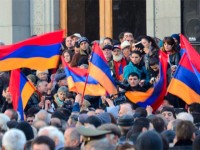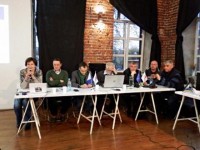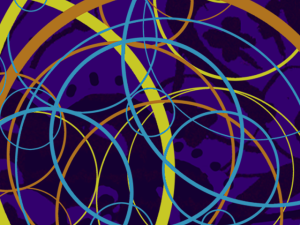The Belarusan National Platform of the EaP CSF issued a statement in connection with the wave of searches in the editorial offices of the Belarusan media and the detention of journalists.
Svetlana Karaseva — on “Orthodox atheists”, religious nature of Belarusans, and religious studies

The question of what lies beyond the earthly has always worried humans and still remains a mystery. However, we still have those, who “encroach on the sacred things”, i.e. sort the religiousness out.
For example, the candidate of philosophic science Svetlana Karaseva, in the series of open lectures “The main question” organized by the Flying University gave a speech “Religiousness in Belarus: from concepts to the initial data”.
It was for the first time in 6 years of the Flying University’s existence that this topic was discussed. EuroBelarus Information Service collected the most interesting things from this lecture.

Transcendental and immanent
The lecturer started with definitions of concepts.
Religious studies is an independent discipline in the system of social and humanitarian knowledge. The data that the religious studies work with is the empirical data.
This discipline uses the data accumulated by other disciplines, which is connected with the subject of religious studies — religion, i.e. the phenomenon that penetrates all structures of human life. Religious studies is a discipline that studies religion in all its forms and aspects. Religion is a symbolically completed system of representatives, activity, and institutions based on the experience of transcendental. This definition has two aspects: systems (an external one) and experience (an internal one).
Transcendental is the one that lies “beyond” (from Latin transcendent — “climbing over”); thus, something that lies beyond the world borders.
The reality which is presented as transcendental in different religions, is at the same time imminent to the world. This duality of all religious objects is represented in legends. For example, Islam has Allah that is transcendental to the world; it also has a prophet and the Koran, which make the God’s plan on the world and human visible. The triplicity of God the Father, God the Son, and God the Holy Spirit has the same structure: the transcendent Father reveals his plan on the world and human through two other personifications.

The transcendent (religious) experience
Religious legends constantly record the ideas of this kind. In a narrow sense, it is a condition in which a person finds him— or herself in the immediate connection with a transcendent reality. The man, who survived this religious experience, becomes motivated not by physical but spiritual needs; tries not to use but serve; the selfishness is replaced by altruism.
In a broad sense, it is an idea that people are looking for. As a rule, such person has a personality of a prominent scale. Such people are the basis of the religious ideal’s transmission. Any phenomenon that brings a person closer to this ideal is regarded as a religious experience.
First, people have to explain to themselves what has happened to them. This will manifest itself in some external symbolic forms, too. For example, when the Buddha understood the meaning of his awakening, he said that the world has sufferings that have their reasons; these reasons can be overcome and there is a way to overcome them. Any religious truth has the same power and aphoristic nature.
All of this exists as a scenario of life organization, the goal of which is the ideal of a religious ideal.
The system of religious activity includes the principles, forms, and ways of behavior that form a human towards achieving the ideal.
Religiosity means involvement in religion. Religion exists as experience, as a system, and as a tradition.
“Religion exists as long as there are people willing to continue the ideals of religion. Therefore, in my opinion, it’s not quite correct to say that religion is a system of social violence,” Svetlana Karaseva says.

What do non-religious people believe in?
Primitive religions developed first; the archaic and classical civilizations of antiquity followed them. There is no common border for the occurrence of historical religions. And there are those that occur at the borders of eras and areas. Now it’s time of syncretic, eclectic religions, those that are transformed.
Now religious studies enquire into such forms as the quasi-religion — an ideology with certain claims (nationalism, socialism, and liberal humanism). Blind faith and latent religion (when it participates in the creation of values that are the part of secular culture), the inner religion — any form of involvement in value (not necessarily into a religion), secular religion or non-religion — the study of what atheists believe in. The use of certain concepts causes conflict of non-understanding between the experts and the public. These concepts are updated and improved in the research community, while obsolete ones continue functioning in the mass consciousness. So it’s better to abstain from applying many usual definitions. For example, now the word "church" often mean religion, which is wrong, as the church is the institutional form of a religious tradition — Christianity. By Christianity people also often mean Orthodoxy or Catholicism, but these are only denominations inside the religious traditions of Christianity.

Paradoxes of Belarusan religiosity
Sometimes, when analyzing different sources for the study of religion, paradoxes arise. For example, the official statistics that takes account of religious communities, which register themselves as legal entities. Thus, on January 1, 2014 Belarus had more than 1,500 religious communities and about five hundred Catholic communities. A total of some close Protestant communities outnumbers the Catholic ones.
However, figures obtained with the help of public opinion polls indicate that 60 — 70% of the population call themselves religious. 86% of them identify themselves with Orthodoxy, 12% — with Catholicism, and 2% — with other faiths. And those Protestant communities, which exceed the number of the Catholic ones, are dissolved in these 2%.
“Practice shows that the priest knows such number of his parish that coincides neither with the official statistics nor with polls,” Svetlana Karaseva adds.
The question is, how many people who consider themselves to be of a particular faith, are religious.
“When a survey in connection with the introduction of the religion course was conducted in schools, the majority of answers to the question “what religions you know” mentioned Islam and Buddhism,” the researcher said.
Faculty of Philosophy and Social Sciences together with the Institute of Theology of the Belarusan State University are going to conduct a study of religiousness in Belarus. According to it, it’s possible to single out 4 levels of Belarusans’ involvement in religion. Strong — when a person leads a religious way of life. Middle — when a person sympathized with the religious ideal, recognizes its values, but is not ready to organize his or her way of life in accordance with them. Weak — when one recognizes the value of the religious ideal, but does not set a task to follow such way of life. And nominal religiousness — when a person is an "Orthodox atheist". In the opinion of Svetlana Karaseva, a new study will shed light on the state and prospects of influence that religions have on Belarusans.
Video open lecture 
Others
-
Statement of the Belarusan EaP CSF National Platform on solidarity with the civil society of Armenia
The Belarusan National Platform of the Eastern Partnership Civil Society Forum issued a statement on solidarity with the civil society of Armenia.
-
Statement of the BNP in connection with the criminal prosecution of the leaders of the Belarusan independent trade unions
The Belarusan National Platform of the Eastern Partnership Civil Society Forum issued a statement in connection with the criminal prosecution of the leaders of the Belarusan independent trade unions.
-
Final event of project CHOICE — Paving the way to European Year of Cultural Heritage 2018
The final event of the two-year EU funded project CHOICE — Cultural Heritage: Opportunity for Improving Civic Engagement was held on June 6, 2017 at the Committee of the Regions, in Brussels.
-
Heritage is a verb. The results of the CHOICE project were summarized in Minsk (Photos and video)
Does Belarus need a “Public Ministry of Culture” and “Ašmiany Charter” to deal with the historical and cultural sites?








Comments
Andrei Yahorau — Al Jazeera: “Lukashenko is irresponsible”
He said Belarus would likely face economic tightening not only as a result of the coronavirus pandemic but also a Russian trade oil crisis that worsened this past winter.